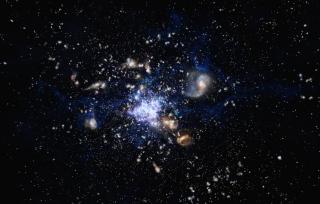Bibcode
Stanley, F.; Jones, B. M.; Riechers, D. A.; Yang, C.; Berta, S.; Cox, P.; Bakx, T. J. L. C.; Cooray, A.; Dannerbauer, H.; Dye, S.; Hughes, D. H.; Ivison, R. J.; Jin, S.; Lehnert, M.; Neri, R.; Omont, A.; van der Werf, P.; Weiss, A.
Referencia bibliográfica
The Astrophysical Journal
Fecha de publicación:
3
2023
Revista
Número de citas
16
Número de citas referidas
14
Descripción
We present the results of a survey of CO(1-0) emission in 14 infrared luminous dusty star-forming galaxies (DSFGs) at 2 < z < 4 with the NSF's Karl G. Jansky Very Large Array. All sources are detected in 12CO(1-0), with an angular resolution of ~1″. Seven sources show extended and complex structure. We measure CO luminosities of $(\mu ){L}_{\mathrm{CO}(1-0)}^{{\prime} }=0.4\mbox{--}2.9\times {10}^{11}$ K km s-1 pc2, and molecular gas masses of $(\mu ){M}_{{{\rm{H}}}_{2}}\,=1.3\mbox{--}8.6\times {10}^{11}$ M ⊙, where (μ) is the magnification factor. The derived molecular gas depletion times of t dep = 40-460 Myr, cover the expected range of both normal star-forming galaxies and starbursts. Compared to the higher -J CO transitions previously observed for the same sources, we find CO temperature brightness ratios of r 32/10 = 0.4-1.4, r 43/10 = 0.4-1.7, and r 54/10 = 0.3-1.3. We find a wide range of CO spectral line energy distributions (SLEDs), in agreement with other high-z DSFGs, with the exception of three sources that are most comparable to Cloverleaf and APM08279+5255. Based on radiative transfer modeling of the CO SLEDs we determine densities of ${n}_{{{\rm{H}}}_{2}}=0.3-8.5\times {10}^{3}$ cm-3 and temperatures of T K = 100-200 K. Lastly, four sources are detected in the continuum, three have radio emission consistent with their infrared-derived star formation rates, while HerBS-70E requires an additional synchrotron radiation component from an active galactic nucleus. Overall, we find that even though the sample is similarly luminous in the infrared, by tracing the CO(1-0) emission a diversity of galaxy and excitation properties are revealed, demonstrating the importance of CO(1-0) observations in combination to higher-J transitions.
Proyectos relacionados

Gas Molecular y Polvo en Galacias através del Tiempo Cósmico
Dos cuestiones fundamentales en la Astrofísica son la conversión de gas molecuar en estrellas y cómo este proceso físico depende del entorno en todas las escalas, desde sistemas planetarios, cúmulos estelares, galaxias hasta cúmulos de galaxias. El objectivo principal de este proyecto es el de estudiar la formación y evolución de galaxias a partir
Helmut
Dannerbauer